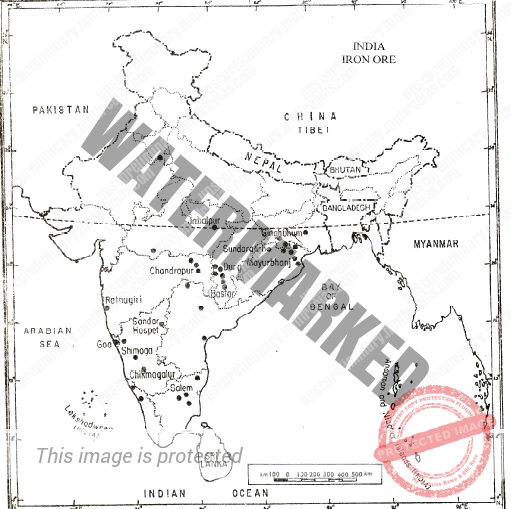- DISTRIBUTION OF MINERALS
- METALLIC MINERALS, FERROUS MINERALS
- DISTRIBUTION OF IRON ORE
UNIT 6 – MINERALS AND RESOURCES – PART 3
DISTRIBUTION OF MINERALS
Metallic Minerals:
These contains one are more metals. In general, they are good conductors of heat and electricity.
They further divided into
- Ferrous
- Nin – Ferrous
- Precious Minerals.
Ferrous Minerals:
These are naturally occurring inorganic substance that contains Iron as an element in their composition.
Those have highly magnetic properties and amount about 3/4th of total value of production of metallic minerals. E.g.: Iron, Manganese.
Iron: India possesses over 20 percent of the world’s total reserves. The quality of Indian ore is very high.
Important iron ores are: –Hematite, magnetite and limonite.
Magnetite ore contains more than 70% percent of iron. It is the best quality iron ore. It is dark brown to blackish in colour and is often referred as ‘black ores’.
Hematite contains up to 60 percent of the iron. Next to magnetite in quantity and richness is the hematite ore. It is red in color and is often referred to as ‘red ore’. It is Useful in Industrial production. Limonite is the third type of ore which has iron content of 35-50 percent. It is yellow in colour. Since India has large reserves of hematite and magnetite ores, inferior quality ore like limonite is rarely exploited.
Distribution of iron ore:
Australia is the largest producer of Iron worldwide. India sands at fourth in this list. India possesses over 20 percent of the world’s total reserves in iron.
In India Iron ore deposits are found practically in every state. However, 96% of the total reserves are in Orissa, Jharkhand, Chhattisgarh, Karnataka, and Goa.
These states also account for 96 percent to the total production of iron ore in the country. About 3 percent of the country’s total production comes from Tamil Nadu, Maharashtra, and Andhra Pradesh.
Orissa and Jharkhand together possess about 50 percent of India’s reserves of high-grade iron ore.
The principal deposits are located in Sundargarh, Mayurbhanj and Keonjhar districts of Orissa and Singhbhum district of Jharkhand.
Chhattisgarh and Madhya Pradesh contributed about 25 percent of country’s total iron ore reserves and about 20-25 percent of country’s production of iron ore. The reserves are located in Bailadila range, Raoghat area in Bastar district and Dhalli Rajhara range in Durg district.
Goa possesses inferior quality ore but its contribution to the country’s total production is impressive. Most of the mines are open cast and mechanized. Almost the entire production of iron from Goa is exported from Marmagao Port to Japan.
In Karnataka, the most important deposits are found in the Sandur-Hospet area of Bellary district; Babaudan hills of Chikmagalur district and in Simoga and Chitradurga district.
Iron ore deposits of Andhra Pradesh are scattered in the Anantpur, Khammam, Krishna, Kurnool, Cuddapah and Nellore districts. Some deposits are also located in the state of Tamil Nadu, Maharashtra and Rajasthan.
India contributes about 7 to 8 percent of the total production world trade. Now deposits are being worked out specially for export purpose. For example, Bailadila and Rajhara mines of Chhattisgarh and Kiruburu mines in Orissa are being worked for this purpose. Japan, Romania, the former Czechoslovakia and Poland are important importing countries. Iron ore is exported from Haldia, Paradip, Marmagao, Mangalore and Visakhapatnam ports.

